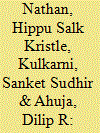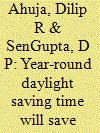|
|
|
Sort Order |
|
|
|
Items / Page
|
|
|
|
|
|
|
| Srl | Item |
| 1 |
ID:
125706


|
|
|
|
|
| Publication |
2013.
|
| Summary/Abstract |
India's energy situation is characterized by increasing energy demand, high fossil fuel dependency, large import shares, and significant portion of population deprived of modern energy services. At this juncture, natural gas, being the cleanest fossil fuel with high efficiency and cost effectiveness, is expected to play an important role. India, with only 0.6% of proven world reserves, is not endowed with adequate natural gas domestically. Nevertheless, there are gas reserves in neighbouring regions which gives rise to the prospects of three cross border gas pipeline projects, namely, Iran-Pakistan-India, Turkmenistan-Afghanistan-Pakistan-India, and Myanmar-Bangladesh-India. This study is a political analysis of these pipeline projects. First, it provides justification on use of natural gas and promotion of cross border energy trade. Then it examines these three pipeline projects and analyses the security concerns, role of different actors, their positions, shifting goals, and strategies. The study develops scenarios on the basis of changing circumstances and discusses some of the pertinent issues like technology options for underground/underwater pipelines and role of private players. It also explores impact of India's broader foreign relations and role of SAARC on the future of pipelines and proposes energy induced mutually assured protection (MAP) as a concept for regional security.
|
|
|
|
|
|
|
|
|
|
|
|
|
|
|
|
| 2 |
ID:
111459


|
|
|
|
|
| Publication |
2012.
|
| Summary/Abstract |
Many countries have experimented with daylight saving time (DST) to save energy and to align human activities more closely to the daily cycle of light and darkness. Using a novel methodology, we estimate the year-round energy savings to be obtained from advancing Indian Standard Time (IST), from the introduction of DST, and from dividing the country into two time zones. We find that the option of advancing IST consistently saves more energy than the corresponding DST option, which in turn saves more energy than the corresponding time zones option. This is because the energy benefits of advancing IST accrue for the entire year throughout the country, whereas the benefits of DST are confined to summer months and the benefits of two time zones are largely in the lower energy consuming eastern region. We recommend advancing IST by half-hour to being six hours ahead of UTC. This confers the advantages of DST and time zones without their disadvantages and is forecast to save more than 2 billion kWh of electricity every year during evening peaks that are difficult to supply. While these results are India-specific, similar exercises would be useful to many other countries.
|
|
|
|
|
|
|
|
|
|
|
|
|
|
|
|
|
|
|
|
|